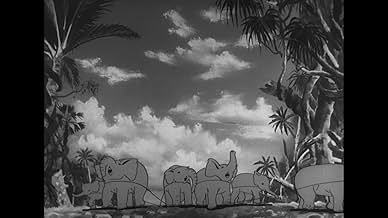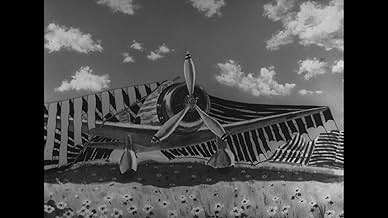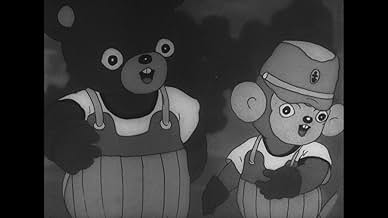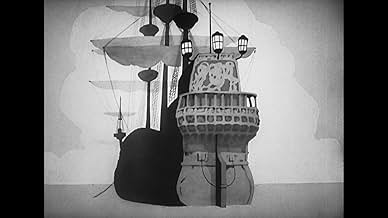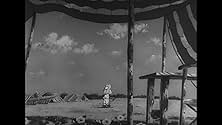Adicionar um enredo no seu idiomaThis animated film--Japan's first--was a propaganda piece made to show the Japanese public how the Japanese military had achieved such decisive victories in the South Pacific. It tells the s... Ler tudoThis animated film--Japan's first--was a propaganda piece made to show the Japanese public how the Japanese military had achieved such decisive victories in the South Pacific. It tells the story of young Japanese boys from their school days to their joining the army and fighting ... Ler tudoThis animated film--Japan's first--was a propaganda piece made to show the Japanese public how the Japanese military had achieved such decisive victories in the South Pacific. It tells the story of young Japanese boys from their school days to their joining the army and fighting against Japan's "enemies" and shows how the animals in the jungle--meant to symbolize the ... Ler tudo
- Direção
- Roteirista
Avaliações em destaque
Often acclaimed as the first anime feature, this movie is a pure propaganda piece divided into three parts. In the first, a member of the corps visits the young animals at home; in the second, they build an airfield in the jungle, aided by the local animals; in the third, they invade, and are totally victorious.
There are some lovely sequences of the fields of home, with dandelions blowing about a field; in the second, there are contemplative views of the clouded sky; the third is all action and caricatures of silhouetted Dutchmen -- labeled 'pirates' and ineffectual Englishmen. It's aimed at children as entertainment, but it's also pure propaganda. In America, almost all animal cartoons fall into the 'funny animal' variety. There are no funny animals here! Although the cutely drawn animals clearly stand in for the children of Japan, they are fierce and dedicated soldiers. Even the rabbits are fearsome and warrior-like in their aspects. Here is propaganda aimed not at adults, but at small children.
For nine tenths of its running time this could pass for a rather dodgy childrens' film in which various fluffy animals in flying suits vaguely resembling the Gremlin in 'Nightmare at 20,000 Feet' sing, frolic about and express their enthusiasm for serving their country as airmen at the shrill urging of the one character in the film who actually looks as if he might be human, the baby-faced, staring-eyed Momotaro.
But when the hectoring Momotaro (who has just the kind of face you'd like to slap) eventually parachutes into 'Devil's Island' with his airbourne comrades to blow up and bayonet swarms of cringing caricature Yanks & Tommies - after which, arms folded, he sternly issues his terms for 'Unconditional Surrender' to their flummoxed commanding officers - one is forcefully reminded of the total lack of magananimity Japan had shown the people of the territories they had occupied throughout the thirties; and remain relieved that this concluding sequence never managed to be more than just a pipe dream.
It's not so easy to be so generous about other aspects of 'Momotaro's divine sea warriors.' There are troubles in the visuals and especially the audio beyond the graininess and lack of total clarity that comes with contemporary technology and the ravages of time. There are small shots and scene of frivolous nothing that serve no apparent purpose but to pad out the length, and these also tend to look worse than the material that is plainly more purposeful. Sometimes the manner in which the camera pans across a scene is weirdly unnatural and off-putting. Elsewhere we'll have long, awkward pauses in which the meaningful audio drops out save for some ambient noise, and it quite pointedly feels like Nothing where there should be Something. This feature isn't the only instance I've ever seen of such matters, but the one other that specifically comes to mind is not a favorable comparison; one way or another, that decided lack of polish just comes across as incomplete, or crude.
Another issue dragging down the film is the notable variability of what it is presenting to us. There is a wild mix throughout these seventy-four minutes, sometimes juxtaposed and sometimes smashed together, of lighthearted silliness befitting any given cartoon that's built for children's entertainment, and the slightly more serious cartoon note of "uh oh, our friend's in trouble, we better help them." There is glorification of Japan, and accentuation of united purpose for a greater cause; performance of wartime duties, maintenance of wartime camps and equipment, and ultimately the commencement of an operation. There is also a history lesson that's narrated over its own distinct art style; an educational segment that would fit right in with any given episode of 'Sesame Street'; and musical sequences. Most of these bits and bobs are fairly well written and animated in and of themselves, and some underlying themes and bigger ideas are genuinely admirable. By putting them all together into a single movie, however, 'Momotaro' sacrifices some sense of cohesiveness.
Granted, despite the mix and match of the writing, it's not possible to mistake 'Momotaro's divine sea warriors' as anything other than the propaganda piece that it was for Imperial Japan during World War II. This core gets peculiarly waylaid every now and again, but it's the primary thrust of the title and heavily, increasingly dominates the latter half. Still, I have to wonder just how effective it could have possibly been in its purpose considering how we swing from "tee hee, chasing a hat that's caught on the wind!" to "no, for real, this is war, and here is a battle with explosions and gunfire." I know the average short from 'Looney Tunes' or 'Merrie Melodies' was also sometimes disproportionately violent, but this exists on a level all its own. Regardless, the messaging is right there for the taking - and in light of the course of history, the picture now exists as a novelty, and a vestige of another time. We can in turn appreciate and criticize the animation and writing in and of themselves, but at the end of the day, it's only the avid cinephile or a history buff who will have any reason to revisit this. Despite its nature, I don't think it's so simple as saying "'Momotaro's divine sea warriors' is bad." I think it's a film at odds with itself. If your curiosity is piqued, as mine was, then by all means check it out, but otherwise you can just not bother and get on with your day.
Você sabia?
- CuriosidadesThis was Japan's first anime (animated feature).
- Versões alternativasThere's a scene where Bluto and Popeye surrender to Japanese forces, which was removed from some home video versions. It was reinstated in the 2K restored version.
- ConexõesFeatured in Cartoons Kick Ass (2000)
Principais escolhas
- How long is Momotaro, Sacred Sailors?Fornecido pela Alexa
Detalhes
- Tempo de duração1 hora 14 minutos
- Cor
- Mixagem de som
- Proporção
- 1.37 : 1
Contribua para esta página


